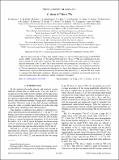β- decay of 65Mn to 65Fe

View/
Date
2013-10-07Author
Olaizola, Bruno
Fraille, L.M.
Mach, Henryk
Aprahamian, Ani
Briz, Jose Antonio
Cal-González, J.
Ghita, Dan Gabriel
Köester, U.
Kurcewicz, Wiktor
Lesher, S.R.
Pauwels, Dieter
Picado, Esteban
Poves, Alfredo
Radulov, D.
Simpson, G.S.
Udías, J.M.
Metadata
Show full item recordAbstract
The low-energy structure of 65Fe has been studied by means of γ and fast-timing spectroscopy at the ISOLDE facility, CERN. A level scheme of 65Fe populated following the β-decay of 65Mn was established for the first time. It includes 41 levels and 85 transitions. The excitation energy of the β-decaying isomer in 65Fe has been precisely determined at 393.7(2) keV. The β-delayed neutron emission branch was measured as Pn = 7.9(12)%, which cannot be reconciled with the previously reported value of 21.0(5)%. Four γ rays and four excited states in 64Fe were identified as being populated following the β-n decay. Four lifetimes and five lifetime limits in the subnanosecond range have been measured using the advanced time-delayed βγγ(t) method. The level scheme is compared with shell-model calculations. Tentative spin and parity assignments are proposed based on the observed transition rates, the calculations, and the systematics of the region. La estructura de baja energía del 65Fe se ha estudiado mediante espectroscopía γ y de sincronización rápida en las instalaciones de ISOLDE, CERN. Se estableció por primera vez un esquema de niveles de 65Fe poblado después de la desintegración β de 65Mn. Incluye 41 niveles y 85 transiciones. La energía de excitación del isómero de desintegración β en 65Fe se ha determinado con precisión a 393,7 (2) keV. La rama de emisión de neutrones con retardo β se midió como Pn = 7,9 (12)%, que no puede conciliarse con el valor previamente informado de 21,0 (5)%. Se identificaron cuatro rayos γ y cuatro estados excitados en 64Fe como poblados después de la desintegración β-n. Se han medido cuatro vidas útiles y cinco límites de vida útil en el rango de subnanosegundos utilizando el método avanzado βγγ (t) retardado en el tiempo. El esquema de niveles se compara con los cálculos del modelo de caparazón. Se proponen asignaciones tentativas de espín y paridad con base en las tasas de transición observadas, los cálculos y la sistemática de la región.
Collections
- Artículos científicos [115]
